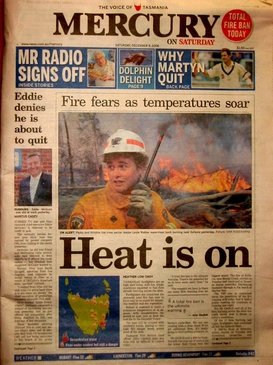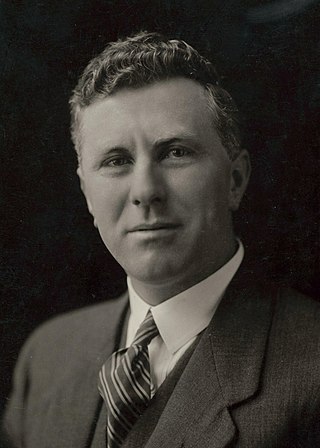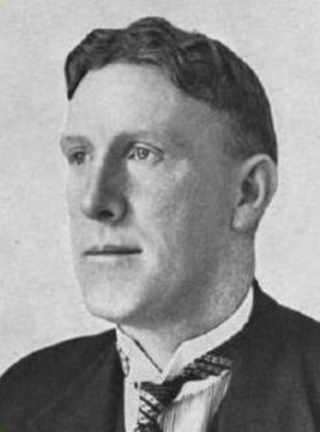
Donald Norman Cameron was an Australian politician. He served in the House of Representatives and Tasmanian House of Assembly.

The Mercury is a daily newspaper, published in Hobart, Tasmania, Australia, by Davies Brothers Pty Ltd, a subsidiary of News Corp Australia, itself a subsidiary of News Corp. The weekend issues of the paper are called Mercury on Saturday and Sunday Tasmanian. The current editor of TheMercury is Craig Herbert.

William Michael Hodgman AM QC was an Australian politician and lawyer. He was a member of the Liberal Party and served as Minister for the Capital Territory in the Fraser government from 1980 to 1983. He was active in both state and federal politics, serving in the Tasmanian Legislative Council (1966–1974), Australian House of Representatives (1975–1987), and Tasmanian House of Assembly. His son Will Hodgman was Premier of Tasmania for 6 years, until his resignation in January 2020.
Graeme Lindsay Sturges is an Australian politician. He was a Labor Party member of the Tasmanian House of Assembly from 2002 to 2010 and 2011 to 2014, representing the Hobart-based electorate of Denison. He was elected twice before losing his seat in 2010, regained it in a countback following the resignation of David Bartlett in 2011, and retired at the 2014 election. He was the state Minister for Infrastructure from 2008 until 2010.

James Allan Guy, CBE was an Australian politician who represented the Australian Labor Party in both the Tasmanian House of Assembly and the Federal House of Representatives, before leaving to represent the United Australia Party and then the Liberal Party of Australia in both the House of Representatives and the Senate. His father, James Guy, had also been a Senator.

George Mason Burns was an Australian politician. He was an Australian Labor Party member of the Australian House of Representatives from 1913 to 1917, representing the electorate of Illawarra. He had previously been a member of the Tasmanian House of Assembly from 1903 to 1906.

James Ernest Ogden was an Australian politician who was elected to the Tasmanian House of Assembly and the Australian Senate.

Charles Richard Howroyd was an Australian politician. He was a member of the Tasmanian House of Assembly from 1909 until 1917, representing the Australian Labor Party until leaving the party in the 1916 Labor split. He was then elected to the Australian House of Representatives at the 1917 federal election, but died only five days later.

Arthur William Hutchin, DSO was an Australian businessman, politician, and army officer. He was a United Australia Party member of the Australian House of Representatives from 1931 to 1934, representing the Tasmanian electorate of Denison.

Gerald William Mahoney was an Australian politician. He was an Australian Labor Party member of the Tasmanian House of Assembly from 1931 to 1934 and of the Australian House of Representatives from 1934 to 1940, representing both the state and federal versions of the seat of Denison.

Alfred Charles Seabrook was an Australian politician. He was a Nationalist member of the Australian House of Representatives for Franklin from 1922 to 1928 and a United Australia Party member of the Tasmanian House of Assembly for Franklin from 1931 to 1934.

George Matthew Foster was an Australian politician. He was a member of the Nationalist Party and served terms in the Tasmanian House of Assembly (1917–1919) and as a Senator for Tasmania (1920–1925). He suffered from shell shock and his term in the Senate was marked by absenteeism. He later became a leader of the temperance movement in Sydney.

John Hartley Chamberlain was an Australian politician. He served as a Senator for Tasmania from 1951 until his death in 1953, representing the Liberal Party. He was also a member of the Tasmanian House of Assembly from 1934 to 1951, briefly serving as deputy opposition leader. He was a farmer at Latrobe prior to entering politics, having taken up land as a soldier settler.
William Henry Thomas Brown was an Australian politician and sailor. He was a member of the Tasmanian House of Assembly from 1882 to 1889 and from 1893 to 1893, both times representing the electorate of Campbell Town.
Sir Eardley Max Bingham, was an Australian politician. He was Deputy Premier and Opposition Leader of Tasmania, who represented the electorate of Denison for the Liberal Party in the Tasmanian House of Assembly from 1969 to 1984.
Roy Frederick Fagan was an Australian Labor Party politician, who was Deputy Premier of Tasmania from 1959 to 1969.
Sir Herbert Nicholls was an Australian judge and politician, who was Chief Justice of Tasmania from 1914 to 1937, and as an independent member of the Tasmanian House of Assembly from 1900 to 1909. In parliament, he served as Attorney-General and Leader of the Opposition.

The Tasmanian Labor Party, officially known as the Australian Labor Party (Tasmanian Branch) and commonly referred to simply as Tasmanian Labor, is the Tasmanian branch of the Australian Labor Party. It has been one of the most successful state Labor parties in Australia in terms of electoral success.
Carmichael Lyne was an Australian politician. He was a member of the Tasmanian House of Assembly from 1900 to 1906, representing the seat of Ringarooma.













